
Day 1
KashgarOur guide will meet you Kashgar. Kashgar was a cultural center of the Uyger nationality in ancient times, a place of strategic importance in the westernmost border area, and a city famous for its historical interest and contacts with other countries.
Day 2
Kashgar-Yecheng-
 Sunday Bazaar
Sunday Bazaar
After breakfast we will visit the famous Sunday Market, We have to prepare the food,drink and fruit for the adventure form today.We’re challenge ourselves to the most difficult route in the world.Drive to Yecheng which is the name of bore of the oasis and the town.The rich loess terraces of the oasis are watered by the Tian of River and several small streams.Upon arrival and check into the hotel and have a good rest to save as much energy as possible. In the following 3-4days, we have to prepare breakfast on ourselves. And we will have picnic lunch. There will be no suitable restaurant.
Breakfast: packed breakfast
Highest point: 2000 m.
Day 3
Yecheng -Hongliutan-
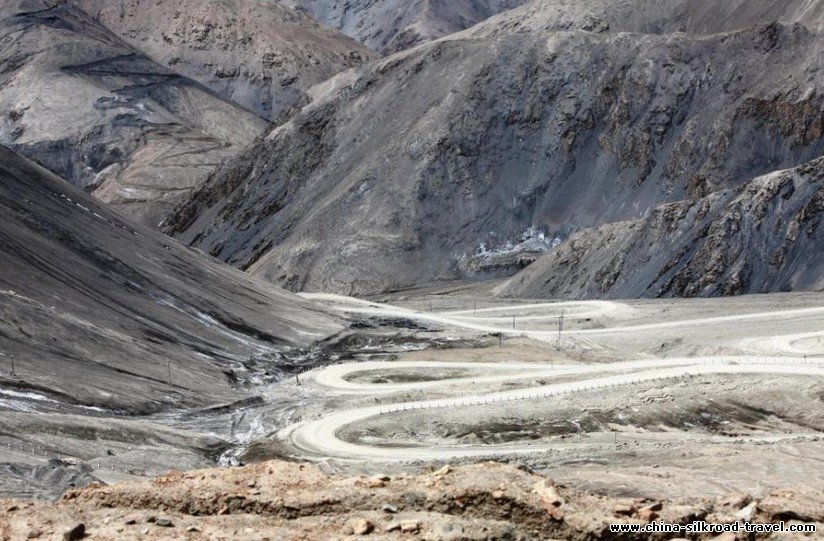 Road in the mountain
Road in the mountain
Breakfast: on you own
Night: Camping or local guest house.
Day 4
Hongliutan-
 Highest point for this tour Jieshan Daban, 5245m
Highest point for this tour Jieshan Daban, 5245m
Get up in the early morning,have simple breakfast which prepared by yesterday.Today will be the hardest day for you.As we ‘ll across the highest and most dangerous point-Jieshan Daban with the sea level of 5245m,fighting!Drive about 300km on the good road which was rebuilt this year.We’ll arrive in hero valley to have lunch.There are many soldiers devoted their young life in building the road from Xinjiang to Tibet,which is also their last home. please note the sealevel of Hero Valley is 5140m.Then we’ll pass by Lomcuo Lake to Jieshan Daban(5300m),which is border between Tibet and Xinjiang,which means we;ll Tibet land.From Jieshan Daban to Duoma,the road is very bad,but we learned from the news that the road construction will be finished in the year of 2014.No exactly time.In this wilderness,we should keep our eyes open for the Tibetan wild Ass or Kiang.Here,if we are lucky,we’ll see not just the few but herds of them.
Breakfast: on you own
Day 5
Duoma-Shiquanhe/Gar-
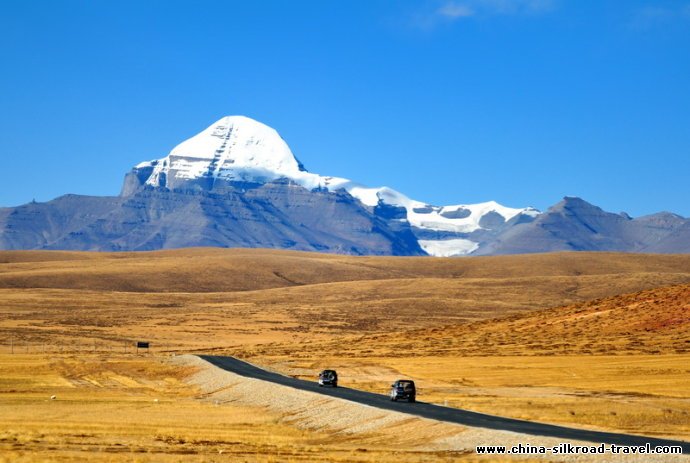 Mt. Kailash
Mt. Kailash
After breakfast we’ll drive Shiquanhe which is the capital city of Nagri.Prefecture located in the western part of Tibet.Nagri is the place of great mountains,beautiful lakes and vast grasslands. Shiquanhe River the main source of the Indus, originates from the Kailash.On the way we visit the Pangong-tso, a long and narrow lake, situated on the border of Indian and China. It is where the Himalayas,the Gradise,the Kulun Mountains and Karakoram Mountains.Nagri is extremely important for both Hindus and Buddhists.Mountain Kailash and Lake Mansarovar in Nagri are the‘Sacred Mountains and Holy Lake’of the Buddhism and are therefore the spirituel center of Buddhists meet ,Mt. Kailash : The spiritual centre of Buddhists as well as Hindus and Bon followers, Mt Kailash is known as Gang Rimpoche in Tibet. Gang Rimpoche means "treasures of the snow mountains" or the "sacredness of snow". It is believed to be the place where Shakyamuni Buddha conducted the rites to save the souls of the dead. It is also believed to be the place referred to as Sumeri Mountains in Buddhism. Circling round the Mt Kailash at any time is considered extremely auspicious and beneficial for pilgrims, however, the best time to circumambulate is believed to be April 15. It was on this day that Buddha Sakyamuni was born, became the Buddha, and also passed away and reached the state of nirvana.The road to Shiquanhe is very bad,while we’ll drive along the beautiful Dangong-ko which means the swan lake with long neck.It is 155kms long from East to West,40ms is km wide from South to North,situated on the border of India and China.Fresh air with fantastic view.
Breakfast: on you own
Day 6
Shiquanhe/Gar--Zhada-

- The Ruins of Guge Kingdom
Early in the morning we drive to Tsaparang, the oldest center of Guge Kingdom. A group of four temples surround the lower part of the fortress walls, one fifth of which lie above the remains of the city, the former Summer Palace of the kings. You will be greeted by the view of vast grassland and great snow mountain. Visit Ruins of Guge Kingdom, which situated on a mountain in Zhabran Village, at a distance of around 18 km west of the county town of Zhada. The kingdom was founded by a descendant of King Glang Darma in the 10th century after his flight from Lhasa (because of the fall of the Tubo kingdom). The kingdom vanished all of a sudden around 400 years back but left back ruins that have become a an invaluable heritage of Tibet. And in the late afternoon enjoy the sunset of Tholing Monastery. It stands to the northwest of the Zhada county, around 300 m away from the rest house opened by the Department of the Armed Forces. Tholing, in Tibet means, "to fly high and never fall". The monastery was established in the 10th century and functioned as an important centre for promoting Buddhism in Tibet. The significance of the monastery deteroriated after the fall of the guge kingdom, however, it is still counted amongst important Buddhist place in Tibet. In its heydays, the monastery consisted of Jiasha Hall, the White Hall, the Eighteen Arhats' Hall, Buddhist Guardian Hall of Atisha (the Indian senior monk), the Hall of Rinchen Zangpo, many monk houses and the forest of pagodas. Worth seeing in the monastery today is the rear hall which has recently been renovated and preserves some brilliant frescoes. Since the monastery is not very far off from the Zhada county town, you can go there on foot. Again a flashlight is essential to explore the monastery properly.
Breakfast: in the hotel
Night: local guest house.
Day 7
Zhada-Tarchen-
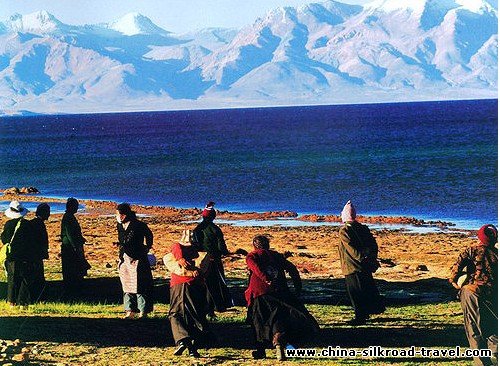 Lake Manasarovar
Lake Manasarovar
Early in the morning we drive to Tarchen in the morning and the road condition is very good. Moving towards about 150kms, you will arrive the Lake Manasarovar.The fresh water lake is 4,588 meters high above sea level and covers an area of 330 square kilometers. The depth of the lake is 81.8 meters. The lake is situated between two snow-covered mountain ranges is extremely beautiful. It is an important part for the Tibetan pilgrims to orbit and take a bath in the lake.You can relax around the lake shore for a while and experience the natural beauty of the lake. In the summer time, flocks of swans will gather on the lake, bringing grace and life to the area. You can also see so many Tibetans and Hindus praying and circuling around the lake shore for the whole day, snow capped mountains on the background and hundreds of swans gathering on the lake, attracting hundreds and thousands of tourists from all over the world.In late afternoon,you will reach Tarchen, where is the beginning of the Mt.Kailash Kora.
Breakfast: in the hotel
Night: local guest house.
Day 8
Tarchen-Saga-
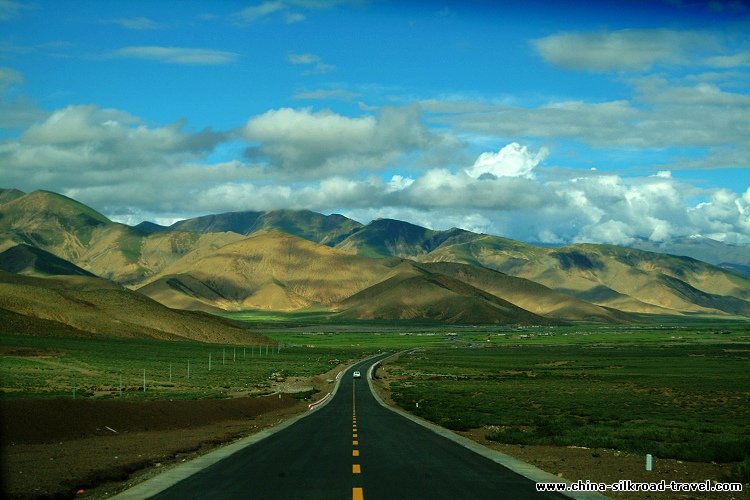 Beautiful view on the way
Beautiful view on the way
Drive from Manasarovar to Saga with rough road wriggles between Himalayas and Gangdis Mountain . It is a hard day of long time drive.Its seat is Saga Town, an army town with a Chinese garrison which patrols the whole length of the Sino-Nepal border. Saga means "happy land" in Tibetan language. Saga straddles the Dargye Tsangpo river above its junction with the Brahmaputra River. It is one of the border counties of Shigatse Prefecture, too. The border line is approximately 105 kilometers long. In the east, Saga County connects to Angren County and Nyelam County. In the south, it connects to Gyirong County and the Kingdom of Nepal. In the west, it connects to Zhongpa County. In the north, it connects to Coqin County of Ngari Prefecture. In addition, Saga County is available in the north of Himalaya Mountain Range and the southwest of Gangdisê Mountains, the upper reach of Yarlung Zangbo River. G219 National Highway is available throughout Saga County. Saga County is proud of more than 1000 years history and well known for a type of dancing in Tibet. The dancing is said to be created for Princess Wencheng when she got married with Songtsen Gampo.
Breakfast: in the hotel
Night: local guest house.
Day 9
Saga-Lhatse-
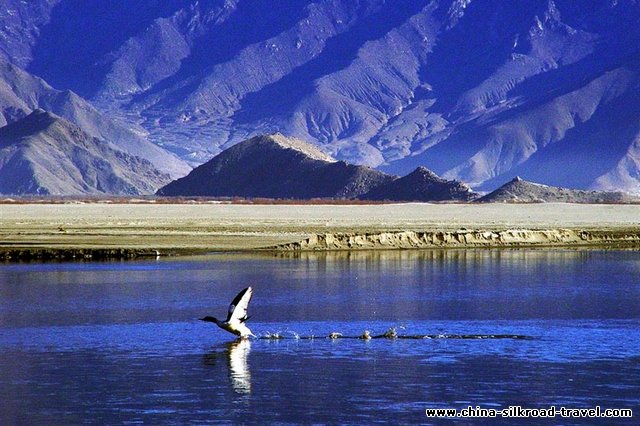 Peiku-tso Lake
Peiku-tso Lake
Early in the morning drive to Lhatse Drive 10hrs around to Lhatse.The road follows north of the Pelgu-Tso, The route then follows a narrow gorge before climbing to a pass and dropping steeply down to a ferry crossing over the Yarlung Tsangpo. continues across the plain with stunning Himalayan views. Peiku-tso is located 40km to the east of Jirong county town and 250km from the Tingri County. It's just on the way to Ngari, between Zhangmu and Saga. With the elavation of 4,590 meters above sea level, Peiku-tso lake is the biggest lake in Shigatse area. It's a light salty lake with an area of more than 300 square kilometers. Surrounded by mountains on three sides, it's bright turquoise all year around.
Breakfast: in the hotel
Night: local guest house.
Day 10
Lhatse-Shigatse-
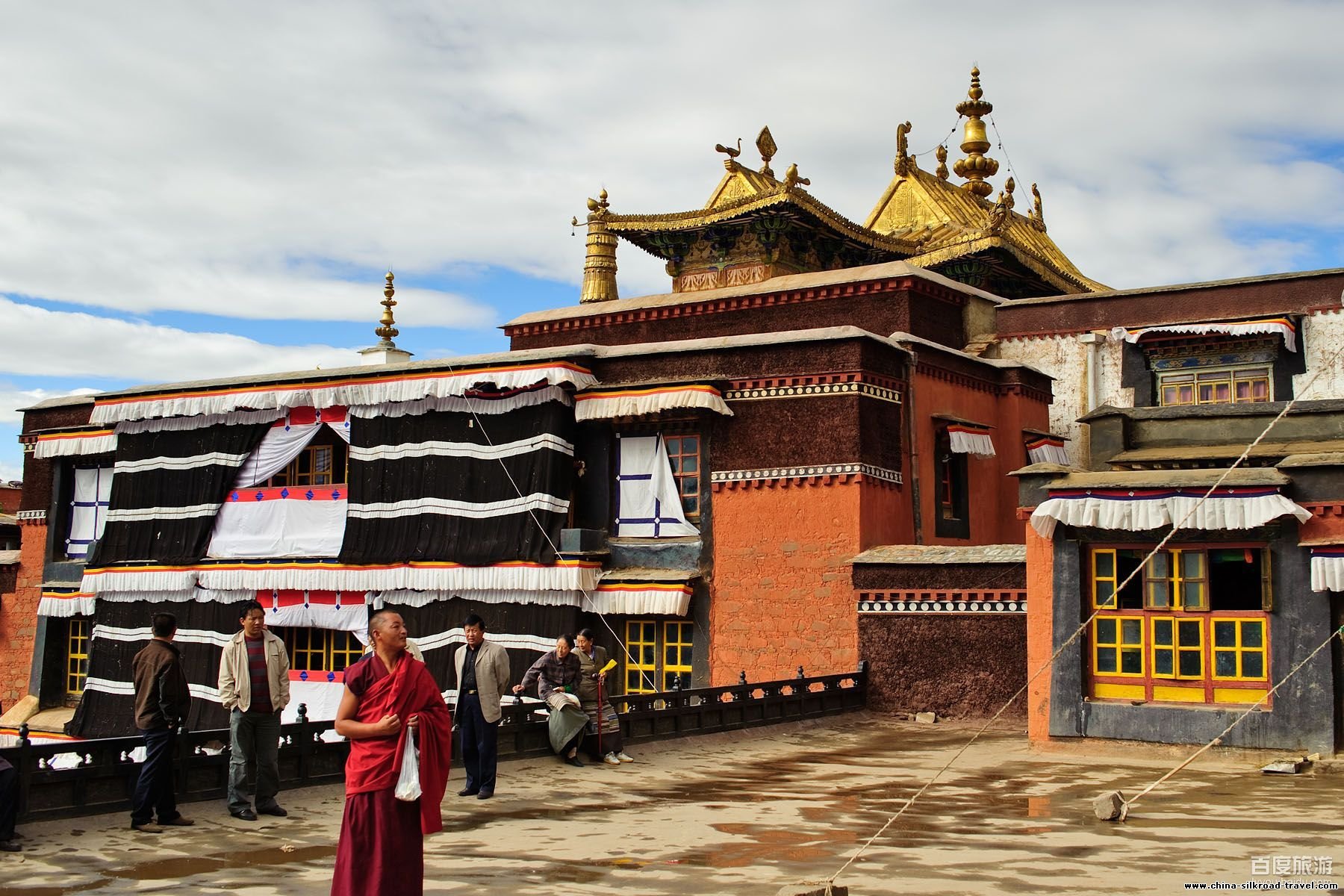 Tashilimpo Monastery
Tashilimpo Monastery
Drive to Shigatse to visit Pachen Lama's seat palce, the great Tashilumpo monastery, a very big and complex monastery in Tibet. Have a look at the Local Market.Tashilumpo Monastery was founded in 1447, which is recorded hightest Lama in the Gelukpa tradition, and the seat of sucessive Panchen Lamas in the Xigaze Prefecture. It is located on a hill in the center of the city, the full name in Tibetan of the monastery means "all fortune and happiness gathered here" or "heap of glory". The Tashilumpo monastery remains popular among the tibetans, as they carry on coming here on pilgrimage.
The monastery is an interesting sprawling amalgam of traditional Tibetan monastic style halls, chapels and other structures connected by precipitous steps and narrow cobblestone alleys. The interplay between Tashilumpo's golden roofs and its white, red and black exterior walls creates a striking composition
Breakfast: in the hotel
Night: Hotel.
Day 11
Shigatse-Lhasa-
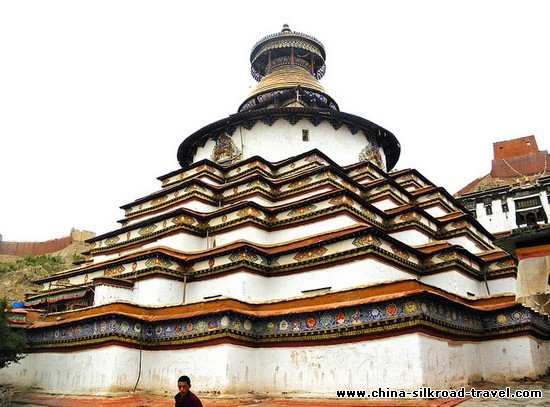 Kumbum Stupa of Pelkhor Monastery
Kumbum Stupa of Pelkhor Monastery
In the morning rive to Gyangtse the fourth largest city in Tibet (after Lhasa, Shigatse and Chamdo) notable for the Kumbum Stupa of the Pelkhor Monastery. And then head to Lhasa the cultural capital of Tibet as well as the administrative center for the Tibet Autonomous Region. In the older parts of the city, especially near the Potala Palace and Jokhang Temple, expect to be enchanted by spinning prayer wheels, colorful flags and traditionally clad Tibetans going about their Buddhist business.
The Kumbum was built after 1418 and was an important centre of the Sakya school of Tibetan Buddhism. This religious structure contains 108 chapels in its four floors, and is illustrated with over 10,000 murals, the last of its type in Tibet. Many of the new clay statues are of less artistry than the destroyed originals - but they are still spectacular.
Breakfast: in the hotel
Night: Hotel
Day 12
Lhasa-
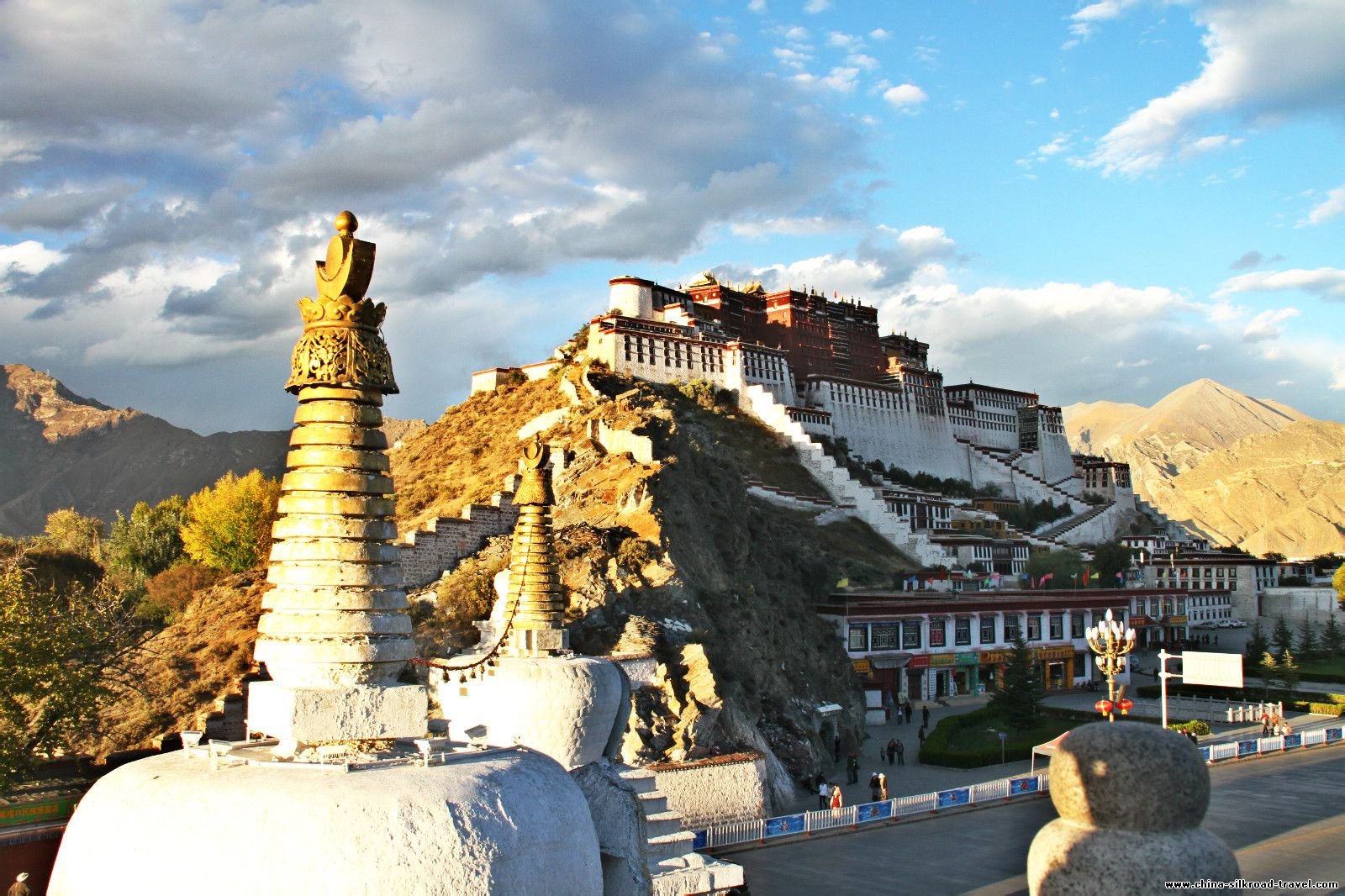 Potala Palace
Potala Palace
After breakfast, we go to the Potala Palace, a golden feather upon the roof of the world, which Tibetans proudly claim to be the prime miracle since the creation of this world. It is visible from any distance, with the golden roof shinning in the sun, spend one hour wondering around the inside of this magnificent building exploring the rooms previously used by the Dalai Lama and the many Buddhist icons within. In the afternoon we go inside of the Jokhang. The Jokhang, like most of the larger temple structures have numerous individual temples within it dedicated to specific enlightened beings, protectors, high lamas, or saints. Images, both sculpted and painted, are everywhere. Every inch of wall and ceiling is brightly painted with images of clouds, beings, mandalas, or decorative patterns. Colorful silk banners, three stories high, hang in various places. Color, pattern, and images crowd in around you. The central image inside the building is a 30-foot high gilded image of Maitreya Buddha. Then stroll around the back alleys of the Barkhor area of Old Lhasa. The streets smelled of yak butter and incense while hordes of pilgrims shuffled along the main Kora (circumambulations) around Jokhang Temple. If someone just walked at a normal pace, one kora would take about 15-20 minutes.
Day 13
LhasaIn the morning have a tour for Drepung, the ever largest monastery with more than 10 thousand monks, Buddhist debates often occur there. Seen from afar, its grand, white construction gives the monastery the appearance of a heap of rice. As such, it was given its name which, in the Tibetan language, means Monastery of Collecting-Rice. Learn about the lives of Tibetan monks there. The afternoon is spent touring Sera Monastery, have a little hike for the beautiful valley scenery nearby and picnic there, in the afternoon, visit Sera monastery, which was created in 1419 and has always been an important Buddhist seminary. As rose are planted everywhere in the monastery, it is also called “the court of wild rose”. Today still 200 lamas live in there. Catch the famous debate session of the monks before returning back to Lhasa.
Day 14
LhasaAfter breakfast you will be transferred to the airport/train station to your next destination.
Price: per person
| Travel in party of |
Superior Class ★★★★★ |
Deluxe Class ★★★★ |
Tourist Class ★★★ |
| 3pax | N | $ | |
| Private tour | price on enquiry | on enquiry | on enquiry |
Service included:
2 Excellent English Speaking guide service
3 Personal Driver + Private 4WD car for Private Transfers & sightseeing
4 Hotels with breakfast(twin share bases) as listed in the itinerary .
5 Travel permit and service charge
6 Travel Insurance
7 Government Taxes .
8 Luggage Transfers between airports and hotels
9 Goverment letter for visa support
Service excluded:
2 Personal expenses, tips to the guide and driver.
Note, the price for 6-10 pax included Lunches and Dinners







